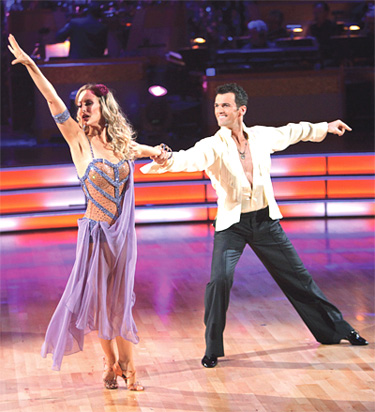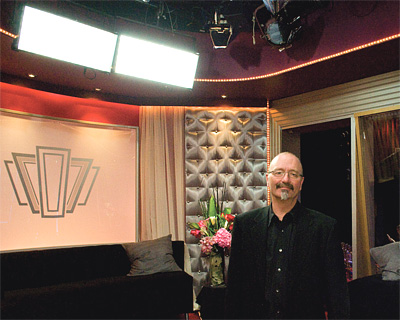Is LED Ready for Primetime?
HOLLYWOOD—Besides being popular primetime reality TV competitions, "Dancing with the Stars" (DWTS), "America's Got Talent" (AGT), and "American Idol" (Idol) have something else in common—they're pushing the envelope on the use of LED (Light Emitting Diode) lighting as both a light source and scenic element.
While LED lighting wasn't considered ready for primetime a few years ago, today lighting professionals associated with these shows—Simon Miles, lighting designer for DWTS; Kieran Healy, lighting designer for Idol and AGT; and Darran Webb, lighting director for Idol and AGT—are now using them alongside conventional studio lighting.
SPOTLIGHTING BENEFITS

“DWTS” mixes and matches different kinds of LED lighting for colorful, dynamic looks. Compared to conventional studio lighting, LED lights throw less heat, consume less power, require less maintenance, streamline production logistics, mitigate fire and burn hazards, and reduce production costs.
"LED lighting has revolutionized the look of the set," said Healy, who won an Emmy in 2009 for outstanding lighting on "American Idol," the famed singing competition now in its tenth season on Fox. "While the 'moving light' was a significant revolution, LED lighting is a very significant new revolution." Moving lights can be programmed and computer-controlled for precision lighting effects.
"On shows like 'Idol,' there is no scenery per se," said Healy. "LED technology, including LED video displays of content residing on servers as well as LED lighting accents, play a big role in creating the dynamic look and feel of the show."
TECHNICAL LIMITATIONS
Simon Miles and Darran Webb agree with Healy that LED lighting is revolutionizing their craft. But all three are quick to point out that despite the rapid advancement of this technology, LED lighting still poses technical limitations that are significant for live television.
Among the problems are inconsistencies between factory batches; difficulties matching color temperatures between different LED fixtures; insufficient brightness and an inability to spotlight subjects, especially from a great distance. RGB (red/green/blue) LED lights can also cause multiple shadows and can also be prone to color shifts and inconsistencies in color temperature that can be especially evident when lighting people's faces— although gels and filters can compensate.
But solutions are also arriving rapidly. For example, LED lighting manufacturer Prism Projection Inc. has incorporated an advanced, proprietary LED color and optics engine within each fixture that automatically measures and adjusts its color and intensity to ensure consistent performance.
Research and development by major lighting manufacturers is also producing a flood of LED lighting products including light boxes, luminaires, strips (such as Pulsar ChromaStrips), and even LED "tape," where the lights are on a flexible, conductive backing that can literally be pulled off a roll and run along surfaces and facades.
INFLUX OF EYE CANDY LIGHTS
On DWTS, Simon Miles said they mix and match different kinds of LED lighting for colorful, dynamic looks that can't be achieved using conventional lights. "We run really innovative LED lighting—such as German-made Schnick-Schnack LED strips, and LED panels for displaying RGB light or video—as perimeter accents around our studio's grand staircases, orchestra pit, balconies, skyboxes, and judge's desk. When you set products like LED tape, strips, or panels close together, the sources give the illusion of a continual band of light."
Miles considers this scenic application "internal lighting" as opposed to studio lighting. But DWTS also uses LED fixtures for studio lighting. For example, Gekko Technology's karesslite fixtures are used off-stage in such areas as a skybox set where dancers go to be interviewed after their performances.
"By stacking several karesslites, you can build a really huge light aperture in a relatively easy fashion versus having to hang several big, hot heavy lights," said Miles. "Compared to conventional lighting, LEDs maintain a soft source light while consuming much less space and power. Since they don't throw off a huge amount of heat, they can be placed in close proximity to people or in small spaces."
However, with the explosion of LED lights on the set, Miles said that DWTS recently approached Production Resource Group (PRG), the maker of their PRG-V676 lighting control board, to request that they double its 2K channel capacity to 4,000. "It's an upgrade they were planning," Miles said, "but they accelerated its development in response to our pressing need to program and control an increasingly complex lighting scheme."
PRODUCTION FRIENDLY
When video crews move from one production location to another, they must compensate for the quality of light emanating from different sources. To solve this run-and-gun challenge, Boston-based Cinematographer Tom Robotham invented the Lowel Blender, which allows operators to adjust between cooler daylight and warmer tungsten lighting.
"If an LED fixture is used as a fill light on a subject who is key-lit by a mixture of daylight and tungsten, the gaffer or camera operator can use the Blender to adjust the LED light to match," said Duane Sherwood, director of communications for Lowel-Light Manufacturing, Inc., owned by Tiffen, Inc. "This speeds up production and results in more aesthetic shots."
For studio applications, Lowel will soon introduce Lowel Prime LED fixtures that output brighter light and a much wider 50-degree beam angle than comparable studio LEDs. Available in daylight or tungsten color, Lowel Primes are DMX dimmable and measure 91+ on the Color Rendering Index (CRI) scale of 1 to 100. "A 91 or better CRI rating ensures an accurate rendition of color quality and temperature."
PLANET FRIENDLY
Recognizing the eco-friendly appeal of LED lighting, most manufacturers either offer LED fixtures or plan to enter the market soon. Philips, a major player in LED lighting, has many products used on these primetime reality shows including its ColorBlast 12 LED fixtures and iColor Cove QL ("i-Cove's") LED strips from its Color Kinetics line; and Philips Vari-Lite VLX Wash and VL Spot Luminaire fixtures.

“Dancing with the Stars” Lighting Director Simon Miles in the Stars Green Room lit with the Gekko karesslite. "LED light technology is advancing rapidly and growing in appeal for the demanding live television application," said Chris Marchitelli, vice president of global marketing for Litepanels, a Vitec Group Brand company in Los Angeles.
Currently, Litepanels' 1x1 Bi-Color LEDs offer color temperatures ranging from tungsten to daylight. Marchitelli said, "This allows production crews to 'dial in' the perfect color temperature to match the location's ambient lighting."
For studio applications, Litepanels 1x1 LED light panels can be configured in 2x1, 2x2, and 3x1 grids, which can enhance live sets. And Litepanels Sola 6 and the new Sola 4 LED fresnel lights, which provide a flicker-free, daylight balanced, focused beam of light, can be mounted on lighting grids and DMX-controlled. "Our LED lights offer a rapid ROI from savings in power consumption, air conditioning, and other operational costs."
According to Darran Webb, the lighting director/gaffer for AGT and Idol, "Since LED lights don't generate heat, you can just leave them on, even in small rooms. This means you don't have to station a tech near the lights to turn them on and off as they're needed, or blast the air conditioning for relief from heat build-up.
"More importantly, you don't have to worry about powering them. We can arrive on location and just plug LED lights into regular wall outlets." Idol sends field crews on location, such as contestant auditions in hotels and stadiums nationwide, often on short notice. Webb said, "We don't need to wait for the house electrician to access the breaker box, or lug in heavy generators to supply the huge amounts of power conventional lights need."
While LED lighting was fairly expensive a few years ago, the prices are now comparable to conventional lights. But Kieran Healy said, "Keep in mind that the overall cost of production is lower with LED lighting when you factor in their lower power consumption; faster, easier set-up; and reduced maintenance." For example, an LED light can last 20,000 hours compared to around 500 hours for a conventional bulb, and gaffers can move them quickly without risking serious burns.
"The next big thing we're looking for is LED moving lights capable of delivering high light output, no shadows, and focus-ability comparable to today's spotlights," Healy said. "But I'm confident that in the next couple of years, we won't be using anything but LEDs."
The professional video industry's #1 source for news, trends and product and tech information. Sign up below.

